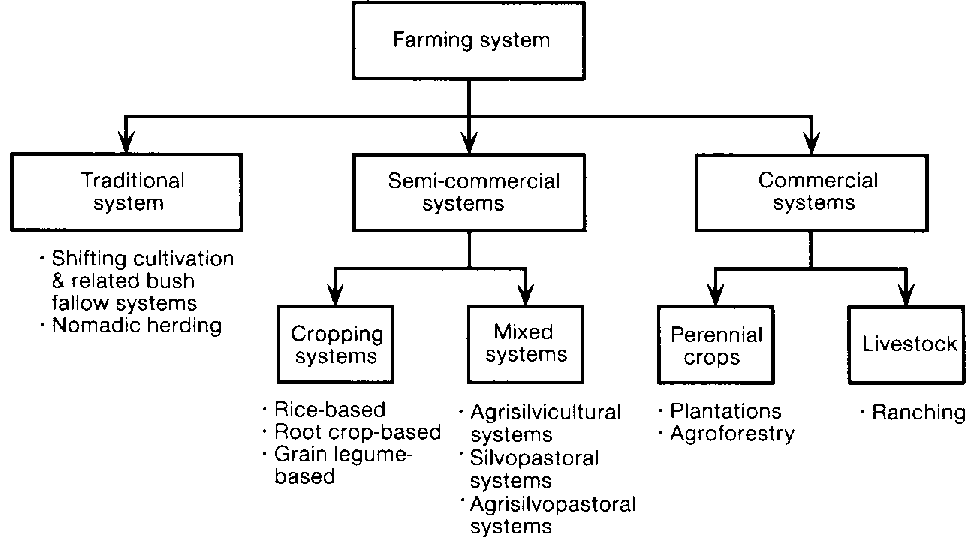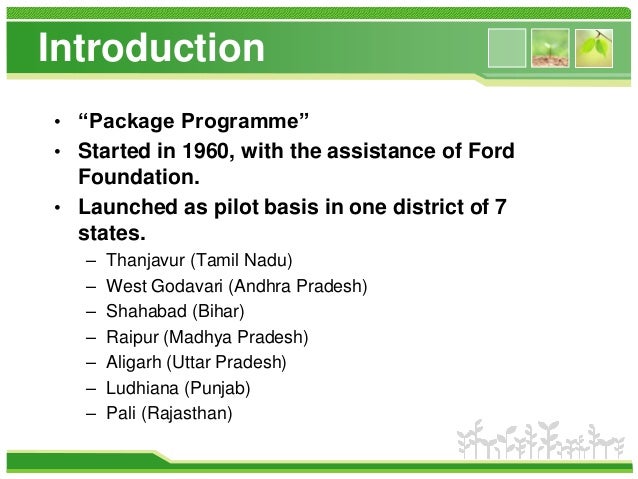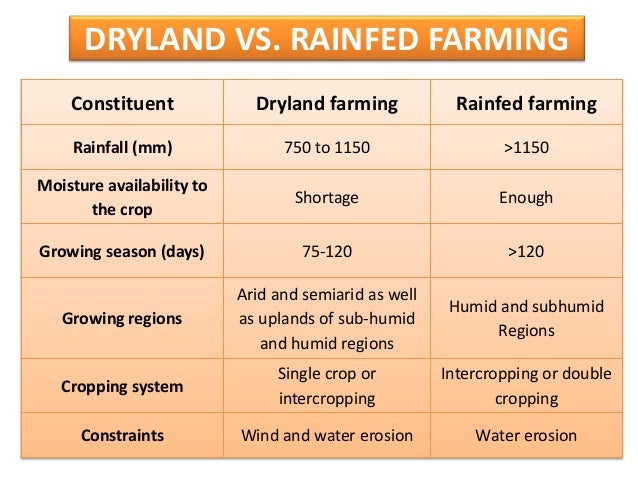
source
Based primarily on nature of land, climatic characteristics and available irrigational facilities, the farmers in India practise different types of farming.
1. Subsistence Farming:

source
- Majority of farmers in the country practise subsistence farming.
- It is characterised by small and scattered land holdings and use of primitive tools.
- As the farmers are poor, they do not use fertilisers and high yielding variety of seeds in their fields to the extent they should do.
- Facilities like electricity and irrigation are generally not available to them.
Features of Subsistence Farming:
- The whole family works on the farm
- Most of the work is done manually
- The farms are small
- Tradition methods of farming are followed
- Yield is not very high
- Most of the yield is consumed by the family with very little surplus for the family
2. Shifting Agriculture:

source
- In this type of agriculture, first of all a piece of forest land is cleared by felling trees and burning of trunks and branches.
- After the land is cleared, crops are grown for two to three years and then the land is abandoned as the fertility of the soil decreases.
- The farmers then move to new areas and the process is repeated.
- Dry paddy, maize, millets and vegetables are the crops commonly grown in this type of farming.
This practice is known by different name in different regions of India like:
- Jhum in Assam,
- Ponam in Kerala,
- Podu in Andhra Pradesh and Odisha and
- Bewar masha penda and Bera in various parts of Madhya Pradesh.
source
As far as possible governments have tried to discourage this practice of cultivation by tribals due to wasteful nature such as soil erosion caused by it, when soil erosion caused by it, when soils are not under cultivation.
3. Plantation Agriculture:

source
- Plantation farming is bush or tree farming. It was introduced by the British in the 19th century.
- It is a single crop farming of rubber, tea, coffee, cocoa, spices, coconut and fruit crops like apples, grapes, oranges, etc.
- It is capital intensive and demands good managerial ability, technical know-how, sophisticated machinery, fertilisers, irrigation, and transport facilities.
- Plantation agriculture is an export-oriented agriculture. Most of the crops grown in plantation agriculture have a life cycle of more than two years.
- Natural rubber, coconuts, oil palm, tea, cocoa, and coffee are all tree crops and take years to mature, but afterwards they are productive for long periods.
- Plantation agriculture is confined within tropical areas, i.e., both sides of the equator. Plantations exist on every continent possessing a tropical climate.
Some of the plantations like tea, coffee and rubber have a processing factory within the farm itself or close to it.
This type of agriculture has developed in hilly areas of north-eastern India, sub-Himalayan West Bengal and in Nilgiri, Anamalai and Cardamom hills in peninsular India.
4. Intensive Farming:
In areas where irrigation has been possible, the farmers use fertilisers and pesticides on large scale. They have also brought their land under high yielding variety of seeds. They have mechanised agriculture by introducing machines in various processes of farming.
Also known as industrial agriculture, it is characterized by a low fallow ratio and higher use of inputs such as capital and labour per unit land area. This is in contrast to traditional agriculture in which the inputs per unit land are lower.
Remember Intensive Agriculture Development program?
Intensive Agriculture Development program (IADP) was the first major experiment of Indian government in the field of agriculture and it was also known as a “package programme” as it was based upon the package approach.
The programme was launched in 1961 after the Community Development Programme lost sheen. The core philosophy was to provide loan for seeds and fertilizers to farmers. Intensive Agriculture Development program was started with the assistance of Ford Foundation.
The IADP was expanded and later a new Intensive Agriculture Area programme (IAAP) was launched to develop special harvest in agriculture area.

source
The IADP was expanded and later a new Intensive Agriculture Area programme (IAAP) was launched to develop special harvest in agriculture area.
5. Dry Agriculture:
Dry farming or dry-land farming may be defined as a practice of growing crops without irrigation in areas which receive an annual rainfall of 750 mm – 500 mm or even less.

source
Key elements of effective combat with perils of Dryland agriculture
- Capturing and Conservation of Moisture
- Effective Use of Available Moisture
- Soil Conservation
- Control of Input Costs
Dryland agriculture is subject to high variability in areas sown, yields and output. These variations are the results of aberrations in weather conditions, especially rainfall. Alternate crop strategies have been worked out for important regions of the country:

6. Mixed and Multiple Agriculture:
- Mixed farming is referred to cultivation of crops and raising of animals simultaneously.
- The multiple farming is used to denote the practice of growing two or more crops together.
- In such case a number of crops having varying maturing periods are sown at the same time.
- This practice is followed is areas having good rainfall or facilities of irrigation.

source
7. Crop Rotation:

source
This refers to growing of number of Crops one after the other in a fixed rotation to maintain the fertility of the soil. The rotation of crops may be complete in a year in some of the areas while it may involve more than one year’s time is others.
- Pulses or any leguminous crop is grown after the cereal crops.
- Legumes have the ability of fixing nitrogen to the soil.
- Highly fertilizer intensive crops like sugarcane or tobacco are rotated with cereal crops.
- The selection of crops for rotation depends upon the local soil conditions and the experience and the understanding of the farmers.
Good time to re-visit the nitrogen cycle again!

source
8. Terrace Cultivation:
- The hill and mountain slopes are cut to form terraces and the land is used in the same way as in permanent agriculture.
- Since the availability of flat land is limited terraces are made to provide small patch of level land.
- Soil erosion is also checked due to terrace formation on hill slopes.

source
Questions from Previous Year’s Prelims
1. Which of the following is the chief characteristic of ‘mixed farming’? [UPSC 2012]
A. Cultivation of both cash crops and food crops
B. Cultivation of two or more crops in the same field
C. Rearing of animals and cultivation of crops together
D. None of the above.
Ans: C
2. With reference to Indian agriculture, which one of the following statements is correct? [UPSC 2002]
A. About 90 per cent of the area under pulses in India is rainfed.
B. The share of pulses in the gross cropped area at the national level has double in the last two decades
C. India accounts for about 15 per cent of the total area under rice in the world
D. Rice occupies about 34 per cent of the gross cropped area of India
Ans: A
3. Which one of the following agricultural practices is eco-friendly ? [UPSC 1999]
A. Organic farming
B. Shifting cultivation
C. Cultivation of high-yielding varieties
D. Growing plants in glass-houses
Ans: A
4. What can be the impact of excessive/ inappropriate use of nitrogenous fertilizers in agriculture? [UPSC 2015]
1. Proliferation of nitrogen-fixing microorganisms in soil can occur.
2. increase in the acidity of soil can take place.
3. Leaching of nitrate to the groundwater can occur.
Select the correct answer using the code given below.
A. 1 and 3 only
B. 2 only
C. 2 and 3 only
D. 1, 2 and 3
Ans: C
5. In India, the problem of soil erosion is associated with which of the following? [UPSC 2015]
1.Terrace cultivation
2. Deforestation
3. Tropical climate
Select the correct answer using the code given below.
A. I and 2 only
B. 2 only
C. 1 and 3 only
D. 1, 2 and 3
Ans: B

The development of agro-based businesses alongside horticultural items delivers more prominent joining with various areas. Another part of characterizing what the agro-based industry is its characterization into two classes – food handling and non-food preparing ventures. Reach Vakilsearch site to know about agriculture business management: https://vakilsearch.com/starting-business-in-agriculture-industry
I am thinking to work on your tips. See here how you can get Government support for your AgriTech startup and grow it more.
The information you provided has been very useful to me. I truly thank you
Types Of Farming In India
Art class in Lajpat Nagar
Thanks for sharing this info
Click here for company registration
Thanks For sharing this valuable information
Trademark Registration Process
Art class in Lajpat Nagar
Your business is one of the most important assets you have. It’s also one of the most complicated and time-consuming legal entities to set up. Fortunately, there are services that can handle most of the nitty-gritty details while you focus on the really fun work of building your business. Wholesale and trading companies are required to register with the local tax authority. The Producer company registration registration is performed on the basis of the law.
Nice post thankyou for sharing with us.
At some point in time, we all are Amateur Bloggers. And at the beginning of our blogging journey, amateur bloggers make many mistakes.Amateur blogging
Thanks For sharing this valuable information. Please Read More Information about Farming
Art class in lajpat nagar
If you want to register your company online with expert professional at reasonable prices, then visit Meraprofit for all types of business registration and legal services.
Information about Form NDH-4
Want to start farming business they why not register under msme and get maximum benefits from government, like loan, rebates etc.
Trademark Registration in Dwarka
Thanks For sharing this valuable information.
Very Nice and Informative article